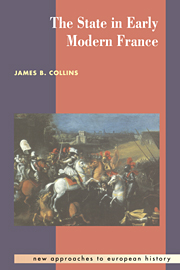Book contents
- Frontmatter
- Contents
- List of illustrations
- Preface
- Chronology of events
- Genealogy
- Glossary
- Historical background: the growth of the French state to 1627
- 1 The crucible, 1620s–1630s
- 2 The twenty years' crisis, 1635–1654
- 3 Louis XIV and the creation of the modern state
- 4 The debacle
- 5 A new France, 1720s–1750s
- 6 Reform, renewal, collapse
- 7 The crisis of 1787–1789
- Bibliography
- Index
- More Titles from the New Approaches to European History Series
5 - A new France, 1720s–1750s
Published online by Cambridge University Press: 05 June 2012
- Frontmatter
- Contents
- List of illustrations
- Preface
- Chronology of events
- Genealogy
- Glossary
- Historical background: the growth of the French state to 1627
- 1 The crucible, 1620s–1630s
- 2 The twenty years' crisis, 1635–1654
- 3 Louis XIV and the creation of the modern state
- 4 The debacle
- 5 A new France, 1720s–1750s
- 6 Reform, renewal, collapse
- 7 The crisis of 1787–1789
- Bibliography
- Index
- More Titles from the New Approaches to European History Series
Summary
War markiz yaouank Pontkaleg ker koant, ker drant, ker kalonek
–Traitour! ah! Malloz dit(Oh the marquis Pontcallec so handsome, so lively, so full of heart
–You who have betrayed him, be damnedThe miserable marquis of Pontcallec and three of his fellow Breton nobles lost their heads to the executioner at Nantes in March 1720. Caught in the web of international politics and local dissatisfaction with the Regency government, they led a tragi-comical uprising whose main act of defiance was a petition signed by 500 mostly minor nobles of western Brittany. Oddly enough, Pontcallec became a popular hero, remembered in countless Breton songs, such as the Gwerz (lament) above. He stood for the popular sense of outrage that the government had lost touch with real life. The fiasco of the Law System, the particular disgust against the forced exile (to Louisiana) of “colonists” (i.e., the vagabond poor and others unfortunate enough to fall into the hands of the guardsmen), the normal instability of a royal minority, the last appearance of the plague (1720–21 near and in Marseilles) – all these combined to make the beginnings of Louis XV's reign inauspicious.
Such appearances hid a deeper reality of profound, largely positive change. The France of the 1750s differed fundamentally from that of the 1710s. France had a larger and more genuinely urban population; it had a new economic structure superimposed on the old one; it had an open political conflict among its elites; it lived in a new intellectual universe.
- Type
- Chapter
- Information
- The State in Early Modern France , pp. 176 - 215Publisher: Cambridge University PressPrint publication year: 1995

